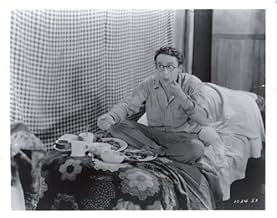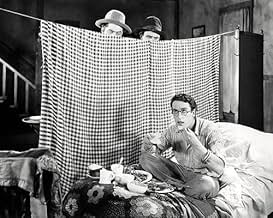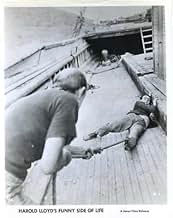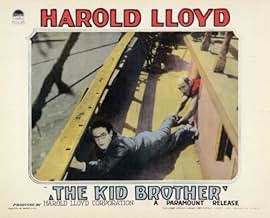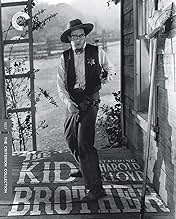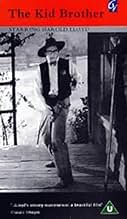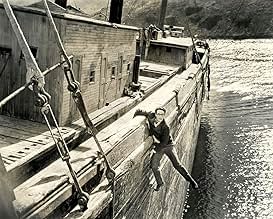NOTE IMDb
7,6/10
5,1 k
MA NOTE
Ajouter une intrigue dans votre langueA sheriff's milquetoast son has a chance to prove himself when a medicine show run by con artists comes into town.A sheriff's milquetoast son has a chance to prove himself when a medicine show run by con artists comes into town.A sheriff's milquetoast son has a chance to prove himself when a medicine show run by con artists comes into town.
- Récompenses
- 2 victoires et 1 nomination au total
Constantine Romanoff
- Sandoni
- (as C. Romanoff)
Ralph Yearsley
- Hank Hooper
- (as R. Yearsley)
Fred Brown
- Townsman
- (non crédité)
Gus Leonard
- Townsman
- (non crédité)
Jim MacIntyre
- Townsman
- (non crédité)
Arthur Millett
- Townsman
- (non crédité)
Frank Mitchell
- Townsman
- (non crédité)
Jocko the Monkey
- Monkey
- (non crédité)
Roger Moore
- Townsman
- (non crédité)
Frank Nelson
- Townsman
- (non crédité)
Avis à la une
As for silent films, I consider "The Kid Brother" every bit as good as Chaplin's "The Gold Rush" or Keaton's "The General" and not too far behind "City Lights", in my mind, the ultimate silent masterpiece. To me it's Harold Lloyd's best and why it isn't more well-known to fans of old movies, I don't know.
Arguably Harold Lloyd's greatest film, made contemporaneously with Buster Keaton's equivalent, THE GENERAL (1927); interestingly, while the former was a box-office hit, the latter's reception was more lukewarm - its reputation having been cemented (indeed vindicated) with time; ultimately, while THE KID BROTHER may lack the scope of Keaton's masterwork, it's no less meticulously crafted or well filmed. Still, it's not quite as renowned as other Lloyds - such as SAFETY LAST! (1923) or THE FRESHMAN (1925) - which actually makes its discovery as an unequivocal gem, not only in the pantheon of comedy but among the finest productions of the Silent era, all the more sweeter!
The plot was admittedly borrowed from the famous Silent melodrama TOL'ABLE David (1921) - which I've never watched myself - but, like THE GENERAL, it seamlessly mingles dazzling comic invention with a serious (a sure indication of this is the fact that it dispenses entirely with Lloyd's typically sarcastic title cards), compelling and exciting plot line; in this case, Harold (again, like Keaton's rejected soldier) has to prove he's the equal of his stalwart family by standing up to the villain - a sinister-looking medicine-show strongman - and recover a cache of stolen money, thus righting a wrong done his father (largely at the instigation of his eternal rival - the long-lasting family feud had also been utilized by Keaton for one of his most beautiful films, OUR HOSPITALITY [1923]).
It's quite futile to mention individual gags from the film because it has a plethora of them, all being incredibly clever (apart from hilarious) and are milked for all they're worth - generally so as to play up to the resourcefulness of our hero. As a matter of fact, the film rarely pauses for breath between one set-piece and the next - while the last half-hour (largely confined to an offshore boat) is thrillingly packed with intense action and suspense, as it speeds towards a happy resolution of all its various plot strands. Jobyna Ralston is once again Lloyd's leading lady here; actually, this proved to be their last collaboration.
I've failed to mention before now the invaluable contribution which the scores by either Carl Davis or Robert Israel have contributed to these Silent films, but Davis' sterling work here (composed for Kevin Brownlow's Photoplay re-issue of 1990) is particularly effective. By the way, the film was started by Lewis Milestone but had to step down from the director's chair due to a contractual dispute; it was taken over by Ted Wilde but even he was replaced (by J.A. Howe) at some later point after he was struck by an illness; this led to the film's shooting schedule extending to a six-month period - but all these various calamities, thankfully, didn't affect the ultimate quality of THE KID BROTHER one bit!
P.S. The film was partly shot on the spot where Forest Lawn cemetery (where many a Hollywood star is buried) was eventually built - and which happens to be located near the Universal studio offices that host the New York Film Academy classes I attended last year!
The plot was admittedly borrowed from the famous Silent melodrama TOL'ABLE David (1921) - which I've never watched myself - but, like THE GENERAL, it seamlessly mingles dazzling comic invention with a serious (a sure indication of this is the fact that it dispenses entirely with Lloyd's typically sarcastic title cards), compelling and exciting plot line; in this case, Harold (again, like Keaton's rejected soldier) has to prove he's the equal of his stalwart family by standing up to the villain - a sinister-looking medicine-show strongman - and recover a cache of stolen money, thus righting a wrong done his father (largely at the instigation of his eternal rival - the long-lasting family feud had also been utilized by Keaton for one of his most beautiful films, OUR HOSPITALITY [1923]).
It's quite futile to mention individual gags from the film because it has a plethora of them, all being incredibly clever (apart from hilarious) and are milked for all they're worth - generally so as to play up to the resourcefulness of our hero. As a matter of fact, the film rarely pauses for breath between one set-piece and the next - while the last half-hour (largely confined to an offshore boat) is thrillingly packed with intense action and suspense, as it speeds towards a happy resolution of all its various plot strands. Jobyna Ralston is once again Lloyd's leading lady here; actually, this proved to be their last collaboration.
I've failed to mention before now the invaluable contribution which the scores by either Carl Davis or Robert Israel have contributed to these Silent films, but Davis' sterling work here (composed for Kevin Brownlow's Photoplay re-issue of 1990) is particularly effective. By the way, the film was started by Lewis Milestone but had to step down from the director's chair due to a contractual dispute; it was taken over by Ted Wilde but even he was replaced (by J.A. Howe) at some later point after he was struck by an illness; this led to the film's shooting schedule extending to a six-month period - but all these various calamities, thankfully, didn't affect the ultimate quality of THE KID BROTHER one bit!
P.S. The film was partly shot on the spot where Forest Lawn cemetery (where many a Hollywood star is buried) was eventually built - and which happens to be located near the Universal studio offices that host the New York Film Academy classes I attended last year!
Even though I had enjoyed several of Lloyd's films, I never really looked at him as being on the same level as Keaton. That's changed after seeing "The Kid Brother." The last half hour is as entertaining as anything on film. Harold's resourcefulness while fighting is a thing to behold! And the monkey with the shoes? Fantastic!
Even by Harold Lloyd's high standards, this is one of his most entertaining and most imaginative movies. It combines humor and melodrama very well, and it is particularly rich in sight gags, again even by Lloyd's standards. Lloyd has a character that is well suited to his style, and he adds some impressive stunts as well.
As "The Kid Brother", Lloyd's character is the put-upon son of a tough sheriff, with two older, domineering brothers. The story has Harold involved romantically with Jobyna Ralston, who comes to town with a traveling medicine show that the sheriff is trying to shut down. There is also a large sum of money that has been collected for a new dam, and entrusted to the sheriff. There is a lot going on, and Lloyd's character faces challenges and difficulties both from his family and from the villains in the medicine show.
The efforts of Lloyd's character to win the respect of his family give the plot some depth that complements the comedy and melodrama well. The action sequences often combine stunts, drama, and visual comedy at the same time, and there are just enough thoughtful moments to keep the important characters from becoming flat. Constantine Romanoff makes a memorable villain, and the lengthy showdown in the old abandoned ship is a wonderful set piece with lots of interesting details.
It's well worth watching a number of times, in order to catch and enjoy everything that Lloyd and the rest of the cast and crew have packed into less than an hour and a half of running time. How fortunate it is that this and Lloyd's other gems have finally come out on DVD for all of us silent movie fans to enjoy.
As "The Kid Brother", Lloyd's character is the put-upon son of a tough sheriff, with two older, domineering brothers. The story has Harold involved romantically with Jobyna Ralston, who comes to town with a traveling medicine show that the sheriff is trying to shut down. There is also a large sum of money that has been collected for a new dam, and entrusted to the sheriff. There is a lot going on, and Lloyd's character faces challenges and difficulties both from his family and from the villains in the medicine show.
The efforts of Lloyd's character to win the respect of his family give the plot some depth that complements the comedy and melodrama well. The action sequences often combine stunts, drama, and visual comedy at the same time, and there are just enough thoughtful moments to keep the important characters from becoming flat. Constantine Romanoff makes a memorable villain, and the lengthy showdown in the old abandoned ship is a wonderful set piece with lots of interesting details.
It's well worth watching a number of times, in order to catch and enjoy everything that Lloyd and the rest of the cast and crew have packed into less than an hour and a half of running time. How fortunate it is that this and Lloyd's other gems have finally come out on DVD for all of us silent movie fans to enjoy.
Comedies like this simply are not made anymore. "The Kid Brother" has some of the most excellent timing of any comedy I've ever seen. Everything from the gag involving Lloyd tumbling out of a tree to the scenes with the monkey toward the end are simply hilarious. The plot is as typical as in any Harold Lloyd film, but that doesn't matter. All that makes these films as great as they are is the sense of timing and the brilliance of the comedy. Fans of Lloyd generally consider this to be his greatest film, and I would simply have to agree with that. Some of his other movies may tend to slow down until they get to a hilarious, climactic ending. The difference with this one is that it is much faster-paced and full of great comedy throughout. The gags in this film simply must be seen to realize how funny they are. You will laugh and laugh at this movie. One of the greatest comedies of all time. They just don't make them this funny anymore.
**** out of ****
**** out of ****
Le saviez-vous
- AnecdotesHarold Lloyd always claimed this to be his favorite among all his films, and, in later years, he proudly screened the film in selected theaters and at film schools.
- Gaffes(At about 40 mins) The view shows a misprinted stereopticon card. The image intended for the right-eye is on the left and the left eye image is on the right. This produces a pseudoscopic stereo effect--visually disconcerting with near elements appearing far away yet obstructing distant elements that appear to be up front. The two stereopticon cards being held seconds later had been printed correctly. It is easy for a careless printer to accidentally switch the views, because the left and right images usually look very similar to each other. Such an error is not noticed during card production unless the stereo pair is checked with a suitable viewer or examined by a person who can "free view" stereo pairs without using any apparatus.
- Citations
Jim Hickory: The Hickoryville citizens have collected their share for the dam and it is now in my keeping. We are now waiting further instructions from you regarding the dam money.
- Versions alternativesIn 1990, The Harold Lloyd Trust and Photoplay Productions presented an 82-minute version of this film in association with Thames Television International, with a musical score written by Carl Davis. The addition of modern credits stretched the time to 83 minutes.
- ConnexionsFeatured in The House That Shadows Built (1931)
Meilleurs choix
Connectez-vous pour évaluer et suivre la liste de favoris afin de recevoir des recommandations personnalisées
- How long is The Kid Brother?Alimenté par Alexa
Détails
- Date de sortie
- Pays d’origine
- Langue
- Aussi connu sous le nom de
- The Kid Brother
- Lieux de tournage
- Santa Catalina Island, Channel Islands, Californie, États-Unis(scenes on the grounded ship)
- Société de production
- Voir plus de crédits d'entreprise sur IMDbPro
Box-office
- Montant brut aux États-Unis et au Canada
- 1 553 522 $US
- Durée1 heure 22 minutes
- Mixage
- Rapport de forme
- 1.33 : 1
Contribuer à cette page
Suggérer une modification ou ajouter du contenu manquant

